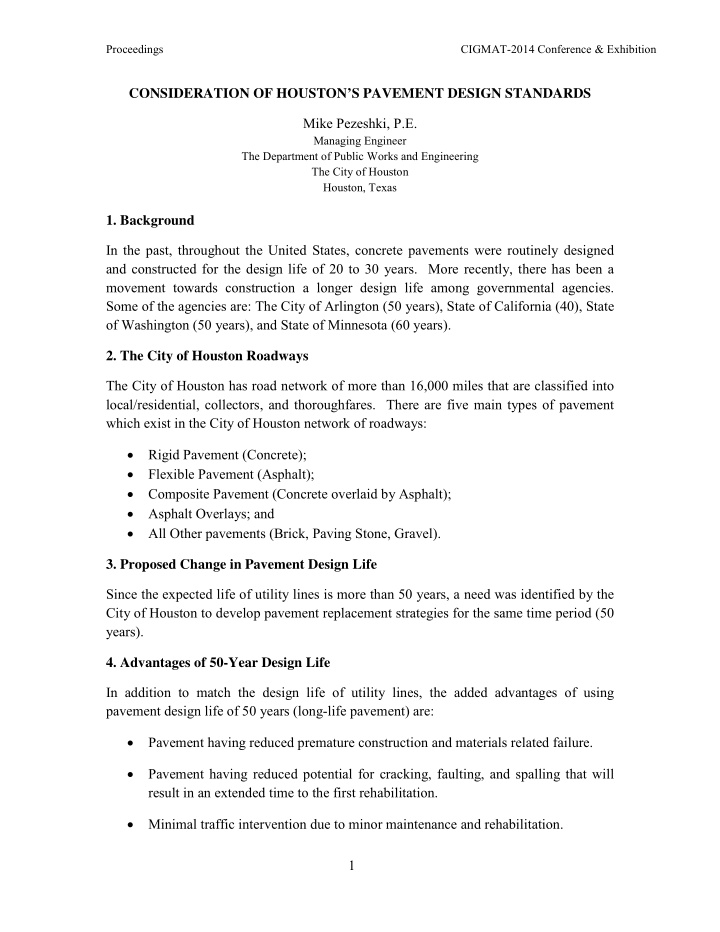



Proceedings CIGMAT-2014 Conference & Exhibition CONSIDERATION OF HOUSTON’S PAVEMENT DESIGN STANDARDS Mike Pezeshki, P.E. Managing Engineer The Department of Public Works and Engineering The City of Houston Houston, Texas 1. Background In the past, throughout the United States, concrete pavements were routinely designed and constructed for the design life of 20 to 30 years. More recently, there has been a movement towards construction a longer design life among governmental agencies. Some of the agencies are: The City of Arlington (50 years), State of California (40), State of Washington (50 years), and State of Minnesota (60 years). 2. The City of Houston Roadways The City of Houston has road network of more than 16,000 miles that are classified into local/residential, collectors, and thoroughfares. There are five main types of pavement which exist in the City of Houston network of roadways: • Rigid Pavement (Concrete); • Flexible Pavement (Asphalt); • Composite Pavement (Concrete overlaid by Asphalt); • Asphalt Overlays; and • All Other pavements (Brick, Paving Stone, Gravel). 3. Proposed Change in Pavement Design Life Since the expected life of utility lines is more than 50 years, a need was identified by the City of Houston to develop pavement replacement strategies for the same time period (50 years). 4. Advantages of 50-Year Design Life In addition to match the design life of utility lines, the added advantages of using pavement design life of 50 years (long-life pavement) are: • Pavement having reduced premature construction and materials related failure. • Pavement having reduced potential for cracking, faulting, and spalling that will result in an extended time to the first rehabilitation. • Minimal traffic intervention due to minor maintenance and rehabilitation. 1
Proceedings CIGMAT-2014 Conference & Exhibition 5. Economic Justifications The 50-year design life will have the following economic benefits: • Lower consumption of raw materials (cement, aggregates, steel) over the design life. • Lower energy consumption because of lesser raw material processing, reconstruction and traffic congestion. • Reduction in pollutants because of manufacturing, construction, congestion. • Higher safety due to infrequent construction zones. • The overall project cost will be increased by 5% to 6%, but life cycle cost will be reduced. • User cost will be reduced (vehicle operating costs, user delay costs, accident cost) because of fewer and shorter work zone periods for future maintenance. • Life cycle costs of 50 year design life (compared to 20 years) will be reduced which will result in long term cost savings to tax payers. 6. Current Requirements and Proposed Minimum Standard • Concrete Slab: The minimum concrete slab thickness Minimum Concrete Slab Thickness Description Current Proposed Residential 6 inches 6 inches Collector 7 inches 9 inches Major Thoroughfare 8 inches 11 inches • Subgrade: The minimum subgrade stabilization depth is proposed as follows: Minimum Subgrade Stabilization Depth Description Current Proposed Residential 6 inches 8 inches Collector 8 inches 12 inches Major Thoroughfare 8 inches 12 inches 2
Proceedings CIGMAT-2014 Conference & Exhibition • Subgrade: Or, the following table will be used for the minimum subgrade stabilization depth. Minimum Subgrade Stabilization depth Plasticity Index < 30% 8 inches > 30% and < 40% 10 inches > 40% and < 50% 12 inches > 50% Evaluation will be needed • Others Items Current Description Proposed Compressive Strength at 28 days 3,500 psi 4,000 psi Flexural Strength at 28 days 600 psi 630 psi Expansion Joint Spacing 80 feet 40 feet Corrosion Protection of Bars None Required Subgrade Compaction ASTM D-698 95% 98% 7. Summary • By increasing pavement life to 50 years (from 20 years), pavement will have reduced potential for distresses that will result in an extended time to the first rehabilitation. • The initial project cost will be increased between 5% and 6%. • Reduces cost over the life of a roadway with lower maintenance cost and extended time to reconstruction. • Life cycle cost will be reduced. • By designing concrete pavements for 50 years with lower life cycle costs, the City of Houston will meet the needs of the present without compromising the ability of future generations to meet their needs. 3
Recommend
More recommend